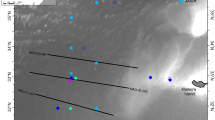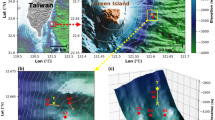Abstract
The global ocean and climate systems are strongly influenced by physical oceanographic processess within the Southern Ocean1. In particular, the exchange of water between subtropical North Atlantic Deep Water and the Antarctic Circumpolar Current controls the rate at which the latter upwells and mixes2. Despite its significance, the details of this exchange are poorly understood. Acoustic imaging of the water column can reveal the detailed thermohaline structure3. Here we present a subsurface acoustic image, acquired in October 1998, that crosses the Sub-Antarctic Front in the South Atlantic Ocean, where the two water masses converge and shear past each other. We find that down to a depth of 2.5 km, the vertical boundary between the North Atlantic Deep Water and the Antarctic Circumpolar Current is sharp and mass exchange is negligible. Below this depth, where cross-track velocities converge, we detect a prominent swirling structure that is 500 m high and 10 km wide. We analyse prestack acoustic records, which suggest that this structure rotates at an average speed of 0.3±0.1 m s−1 about a horizontal axis. We suggest that the structure could either be a thermohaline intrusion created by frontal instability processes, or—more speculatively—a localized and intermittent overturning event.
This is a preview of subscription content, access via your institution
Access options
Subscribe to this journal
Receive 12 print issues and online access
$259.00 per year
only $21.58 per issue
Buy this article
- Purchase on Springer Link
- Instant access to full article PDF
Prices may be subject to local taxes which are calculated during checkout




Similar content being viewed by others
References
Marshall, J. & Speer, K. Closure of the meridional overturning circulation through Southern Ocean upwelling. Nature Geosci. 5, 171–180 (2012).
Jullion, L., Heywood, K. J., Naveira Garabato, A. C. & Stevens, D. P. Circulation and water mass modification in the Brazil–Malvinas confluence. J. Phys. Oceanogr. 40, 845–864 (2010).
Ruddick, B., Song, H., Dong, C. & Pinheiro, L. Water column seismic images as maps of temperature gradient. Oceanography 22, 192–205 (2009).
Orsi, A. H., Whitworth, T. III, Worth, D. & Nowlin, W. D. Jr On the meridional extent and fronts of the Antarctic Circumpolar Current. Deep-Sea. Res. I 42, 641–673 (1995).
Naveira Garabato, A. C., Polzin, K. L., King, B. A., Heywood, K. J. & Visbeck, M. Widespread intense turbulent mixing in the Southern Ocean. Science 303, 210–213 (2004).
Piola, A. R. & Georgi, D. Circumpolar properties of Antarctic Intermediate Waters and Subantarctic Mode Water. Deep Sea Res. 29, 687–711 (1982).
Peterson, R. G. & Whitworth, T. III The Subantarctic and Polar Fronts in relation to deep water masses through the Southwestern Atlantic. J. Geophys. Res. 94, 10817–10838 (1989).
Arhan, M., Heywood, K. J. & King, B. A. The deep waters from the Southern Ocean at the entry to the Argentine Basin. Deep-Sea Res. II 46, 475–499 (1999).
Klaeschen, D., Hobbs, R. W., Krahmann, G., Papenberg, C. & Vsemirnova, E. Estimating movement of reflectors in the water column using seismic oceanography. Geophys. Res. Lett. 36, L00D03 (2009).
Sheen, K. L., White, N. J., Caulfield, C. P. & Hobbs, R. W. Estimating geostrophic shear from seismic images of oceanic structure. J. Atmos. Oceanic Technol. 28, 1149–1154 (2011).
Pinheiro, L.M. et al. Detailed 2-D imaging of the Mediterranean outflow and meddies off W Iberia from multichannel seismic data. J. Marine. Syst. 79, 89–100 (2010).
Krahmann, G., Brandt, P., Klaeschen, D. & Reston, T. Mid-depth internal wave energy off the Iberian Peninsula estimated from seismic reflection data. Geophys. Res. Lett. 113, C12016 (2008).
Sheen, K. L., White, N. J. & Hobbs, R. W. Estimating mixing rates from seismic images of oceanic structure. Geophys. Res. Lett. 36, L00D04 (2009).
Bower, A. S., Rossby, H. T. & Lillibridge, J. L. The Gulf Stream—barrier of blender? J. Phys. Oceanogr. 15, 24–32 (1985).
Sundermeyer, M. A., Ledwell, J. R., Oakey, N. S. & Greenan, B. J. W. Stirring by small-scale vortices caused by patchy mixing. J. Phys. Oceanogr. 35, 1245–1262 (2005).
Smith, K. S. & Ferrari, R. The production and dissipation of compensated thermohaline variance by mesoscale stirring. J. Phys. Oceanogr. 39, 2477–2501 (2009).
Woods, J. D., Onken, R. & Fischer, J. Thermohaline intrusions created isopycnally at oceanic fronts are inclined to isopycnals. Nature 322, 446–449 (1986).
MacVean, M. K. & Woods, J. D. Redistribution of scalars during upper ocean frontogenesis: A numerical model. Q. J. R. Meteorol. Soc. 106, 293–311 (1980).
Klein, P., Treguier, A-M. & Hua, B. L. Three-dimensional stirring of thermohaline fronts. J. Marine Res. 56, 589–612 (1998).
Arhan, M., Carton, X., Piola, A. & Zenk, W. Deep lenses of circumpolar water in the Argentine Basin. J. Geophys. Res. 107, 3007 (2002).
Riley, J. J. & Lindborg, E. Stratified turbulence: A possible interpretation of some geophysical turbulence measurements. J. Atmos. Sci. 65, 2416–2424 (2008).
Lindborg, E. The energy cascade in a strongly stratified fluid. J. Fluid Mech. 550, 207–242 (2006).
Brethouwer, G., Billant, P., Lindborg, E. & Chomaz, J-M. Scaling analysis and simulation of strongly stratified turbulent flows. J. Fluid Mech. 585, 343–368 (2007).
Molemaker, M. J & McWilliams, J. C. Local balance and cross-scale flux of available potential energy. J. Fluid Mech. 645, 295–314 (2010).
Kunze, E., Firing, E., Hummon, J. M., Chereskin, T. K. & Thurnherr, A. M. Global abyssal mixing inferred from lowered ADCP shear and CTD strain profiles. J. Phys. Oceanogr. 36, 1553–1576 (2006).
Wells, M., Cenedese, C. & Caulfield, C. P. The relationship between flux coefficient and entrainment ratio in density currents. J. Phys. Oceanogr. 40, 2713–2727 (2010).
Thorpe, S. A. Turbulence and mixing in a Scottish loch. Phil. Trans. R. Soc. Lond. 286A, 125–181 (1977).
Dillon, T. M. Vertical overturns: A comparison of Thorpe and Ozmidov length scales. J. Geophys. Res. 87, 9601–9613 (1982).
Alford, M. H. Sustained, full-water-column observations of internal waves and mixing near mendicino escarpment. J. Phys. Oceanogr. 40, 2643–2660 (2010).
Klymak, J. M. & Moum, J. N. Oceanic isopycnal slope spectra. Part II: Turbulence. J. Phys. Oceanogr. 37, 1232–1245 (2007).
Acknowledgements
K.L.S. was supported by the NERC UK and by Schlumberger Cambridge Research. Seismic acquisition was financially supported by the NERC. We thank P. Christie, A. Crosby, T. Hesse, K. Heywood, R. Jones, S. Jones, D. Koenitz, D. Lyness, A. Naveira Garabato, C. Richardson, S. Thorpe and C. Trowell for their help. S. Jones and R. Hardy discussed methods of velocity analysis with us. J. B. Sallée provided an incisive review. Department of Earth Sciences contribution number esc.2511.
Author information
Authors and Affiliations
Contributions
This project was conceived by N.J.W. who acquired the seismic data. Processing and analysis was carried out by K.L.S. with guidance from N.J.W., C.P.C. and R.W.H. N.J.W. wrote the paper in conjunction with K.L.S. and C.P.C. K.L.S. and N.J.W. drew the figures.
Corresponding authors
Ethics declarations
Competing interests
The authors declare no competing financial interests.
Supplementary information
Supplementary Information
Supplementary Information (PDF 716 kb)
Rights and permissions
About this article
Cite this article
Sheen, K., White, N., Caulfield, C. et al. Seismic imaging of a large horizontal vortex at abyssal depths beneath the Sub-Antarctic Front. Nature Geosci 5, 542–546 (2012). https://doi.org/10.1038/ngeo1502
Received:
Accepted:
Published:
Issue Date:
DOI: https://doi.org/10.1038/ngeo1502
This article is cited by
-
Erosion and deposition beneath the Subantarctic Front since the Early Oligocene
Scientific Reports (2019)
-
Detecting changes at the leading edge of an interface between oceanic water layers
Nature Communications (2019)
-
Seismic, satellite and site observations of internal solitary waves in the NE South China Sea
Scientific Reports (2014)



